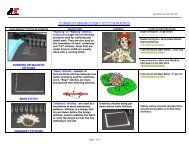Compiled Embroidery Skill Articles
Create successful ePaper yourself
Turn your PDF publications into a flip-book with our unique Google optimized e-Paper software.
10/28/2016 Hat Tricks<br />
oiling it. Although time consuming, this is a necessary step, especially when working<br />
with white or lightcolored products.<br />
FlatBill Caps (Snapbacks)<br />
You can embroider a standard 2½" x 6" design in the center front of a flatbill cap.<br />
The biggest issue with these caps occurs during production when the bills are bent.<br />
Solution: There are no preventative measures for this problem other than being<br />
careful. Have your trimmers straighten the cap bills. Although time consuming, it’ s<br />
the best remedy.<br />
Visors<br />
Visors have more limited space for embroidery — usually about 1¼ inches tall —<br />
and the ideal location is in the front center where they are the tallest.<br />
The maximum design width generally is 44½ inches. The sides of most visors will<br />
only allow embroidery less than 1 inch tall and the back can’t be embroidered at all.<br />
The crown height and curve of a visor should be taken into account when sizing the<br />
design. For example, a visor with a crown height of 2¼ inches tall would best fit a<br />
logo 1¼ inches tall. This would leave ½inch at the bottom and ½inch at the top.<br />
Solution: In your production process, allow for time to modify the customer ’s design<br />
so that you know you can produce a quality result and satisfy the customer . Prior to<br />
taking the job, have your art department work with your customer to adjust the<br />
design. There is no point in taking an order that can’t be produced properly .<br />
Small lettering or detailed designs simply may not work well on visors due to the<br />
small embroidery area. If the design won’t work, try to find another hat that will work<br />
or walk away from the order. It’s not worth the risk of producing a lessthanquality<br />
result.<br />
Five, SixPanel Caps<br />
You can embroider on all four sides of these hats. Many fivepanel caps have mesh<br />
on the sides and a tearaway backing is recommended when embroidering on mesh<br />
for best results. They also have a foamfront panel that creates an issue with<br />
embroidery burying into the foam.<br />
Screen printing is a great alternative, but some clients prefer embroidery .<br />
Solution: Always use a thin font and no fine details in the design. Sixpanel caps<br />
have a seam running down the center . You can embroider right over it as you<br />
commonly do with no loss of quality.<br />
Additionally, designs on a fivepanel cap may be sewn slightly of fcenter without<br />
being readily visible. On sixpanel hats, where there is a center seam, designs even<br />
slightly offcenter may be visually disturbing. Some designs that are weighted to<br />
one side or the other must be placed where they are graphically pleasing.<br />
Examples include italic fonts or images where there is a small element protruding<br />
off to the side of the main part of the logo. The letter “M” with a feather hanging of f<br />
the side of the letter would cause a problem.<br />
When centering on the entire design, including the feather , the center line of the M<br />
would not line up on the center seam of the cap. In these rare cases, center points<br />
must be adjusted offcenter to give the appearance that the design is centered.<br />
Structured/Unstructured Hats<br />
There are two general categories of baseball caps: structured and unstructured.<br />
The structured cap has a stif fer supportive fabric called buckram inside the front<br />
two panels that helps the cap to hold its shape or “spring back” if folded or<br />
crumpled. An unstructured cap means there are no support panels in the front two<br />
panels. Unstructured and structured caps have a maximum embroidery space in<br />
http://impressions.issshows.com/embroiderydigitizing/HatT ricks9833.shtml 3/4




